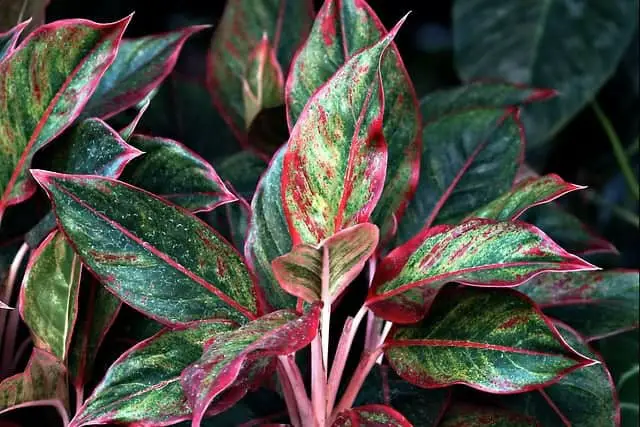Lipstick plants are beautiful and exotic houseplants that can add a pop of color to any room. However, if you notice your lipstick plant dying, it can be a cause for concern. There are many reasons why your lipstick plant may be struggling, but with a little bit of care and attention, you can nurse it back to health.
Understanding the lipstick plant is the first step to caring for it properly. Lipstick plants are native to the rainforests of Southeast Asia, where they grow as epiphytes, which means they grow on other plants instead of in the soil.
They are members of the Aeschynanthus family and are known for their vibrant, tube-shaped flowers that resemble a tube of lipstick. Lipstick plants are typically grown as hanging basket plants and require bright, filtered light to thrive.
Key Takeaways
- Lipstick plants are native to the rainforests of Southeast Asia and grow as epiphytes.
- Lipstick plants require bright, filtered light and an evenly moist potting mix.
- Common reasons for a dying lipstick plant include overwatering, underwatering, and lack of humidity.
More on this category:
Understanding Lipstick Plant
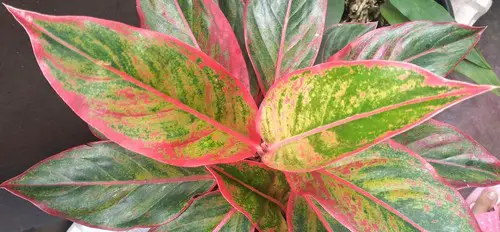
Lipstick Plant Varieties
Lipstick plants are a group of tropical plants that belong to the genus Aeschynanthus. There are over 150 species of Aeschynanthus, with Aeschynanthus radicans being the most commonly grown species. This plant is also known as the lipstick vine or the coral necklace plant.
Lipstick Plant Features
Lipstick plants are native to the tropical rainforests of the Malay Peninsula. They are evergreen perennials that grow as epiphytes, meaning they grow on other plants without harming them.
Lipstick plants have long, trailing stems that can reach up to 3 feet in length. They have glossy, dark green leaves that are about 2 inches long and 1 inch wide.
The most distinctive feature of the lipstick plant is its bright red, tubular flowers that resemble a tube of lipstick. The flowers grow in clusters at the ends of the stems and can last for several weeks. In addition to red, lipstick plant flowers can also be orange, pink, or yellow.
Lipstick plants are relatively easy to care for and can thrive in a variety of conditions. They prefer bright, filtered light and should be kept out of direct sunlight. They also prefer high humidity, so misting the plant regularly can help keep it healthy.
Lipstick plants should be watered when the top inch of soil is dry to the touch, and they should be fertilized once a month during the growing season.
Lipstick Plant Dying – 5 Common Problems
Lipstick plants are beautiful indoor plants that can add color and vibrancy to any space. However, if your lipstick plant is dying, it can be a cause for concern. Here are some reasons why your lipstick plant may be dying:
1. Overwatering
Overwatering is a common problem that can cause your lipstick plant to die. When the soil is constantly wet, the roots can become waterlogged, leading to root rot. This can cause the leaves to wilt and turn yellow or brown. Make sure to water your lipstick plant only when the top inch of soil is dry to the touch.
2. Underwatering
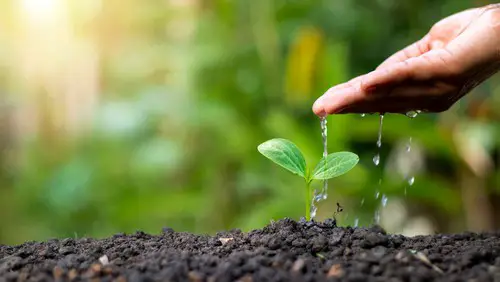
Underwatering is another common problem that can cause your lipstick plant to die. When the soil is too dry, the leaves can wilt and turn brown. Make sure to water your lipstick plant regularly, but do not overwater it.
3. Lack of Light
Lipstick plants require bright, filtered light to thrive. If your plant is not getting enough light, the leaves may turn yellow and drop off. Make sure to place your lipstick plant in a spot that receives bright, filtered light.
4. Pests
Pests such as aphids, mealybugs, and mites can also cause your lipstick plant to die. These pests can suck the sap from the leaves, causing them to wilt and turn brown. Use an insecticidal soap or neem oil to get rid of these pests.
5. Diseases
Fungal diseases such as black spot can also cause your lipstick plant to die. This disease can cause black spots to appear on the leaves, which can eventually lead to leaf drop. Use a fungicide to treat this disease.
Watering Needs and Techniques
Lipstick plants require an evenly moist potting mix. They should never be allowed to dry out completely, as this can cause the plant to wilt and potentially die. The general rule of thumb is to allow the top inch of the potting mix to dry out before watering.
Overwatering is a common problem with lipstick plants, which can lead to root rot and eventual death. To avoid overwatering, it is important to use pots with drainage holes and to never let the plant sit in standing water. It is also important to avoid watering the plant too frequently, as this can lead to waterlogged soil and root rot.
Underwatering can also cause problems for lipstick plants, as they require consistent moisture to thrive. If the soil becomes too dry, the plant may wilt and lose leaves. To avoid underwatering, it is important to establish a regular watering schedule and to monitor the moisture level of the soil.
It is important to note that the watering needs of lipstick plants may vary based on factors such as temperature, humidity, and the size of the plant. In general, it is better to underwater than to overwater, as the plant can recover more easily from slight dehydration than from root rot.
To water a lipstick plant, thoroughly saturate the potting mix until water begins to drain from the bottom of the pot. Be sure to empty the saucer of any excess water to prevent root rot. It is also important to use room temperature water, as cold water can shock the plant and cause stress.
Light and Temperature Requirements

Lipstick plants require bright, indirect sunlight to thrive. They grow best when placed near a south-facing window where they can receive filtered sunlight all year long. Direct sunlight can scorch the leaves, so it’s best to avoid placing them in direct sunlight.
Additionally, lipstick plants require adequate light to bloom. If they don’t receive enough light, they may not produce flowers. If you notice your lipstick plant isn’t blooming, try moving it to a brighter location.
In terms of temperature, lipstick plants prefer indoor temperatures ranging between 75°F to 85°F for optimal growth and flowering. However, they can tolerate temperatures down to 60°F, although the growth may slow down. If indoor temperatures drop to 50°F or lower, the plant may suffer tissue damage and leaf drop.
It’s important to note that lipstick plants are sensitive to sudden temperature changes, so avoid placing them near drafty windows or doors. Maintaining a consistent temperature and humidity level is key to keeping your lipstick plant healthy and happy.
Importance of Soil and Drainage
Proper soil and drainage are essential for the health of a lipstick plant. The right soil will provide the necessary nutrients, while good drainage will prevent overwatering and root rot.
When it comes to soil, a well-draining potting mix is ideal for lipstick plants. This means the soil should allow water to flow through it easily, preventing the plant from sitting in water and becoming waterlogged.
A good potting mix for lipstick plants should contain perlite, which helps with drainage, and compost, which provides nutrients.
It’s also important to ensure that the pot has drainage holes to allow excess water to escape. Without proper drainage, the soil can become waterlogged, leading to root rot and other issues.
In terms of watering, it’s important to allow the top inch of the potting mix to dry out before watering thoroughly. This helps prevent overwatering and ensures that the plant isn’t sitting in water for too long.
Humidity and Misting
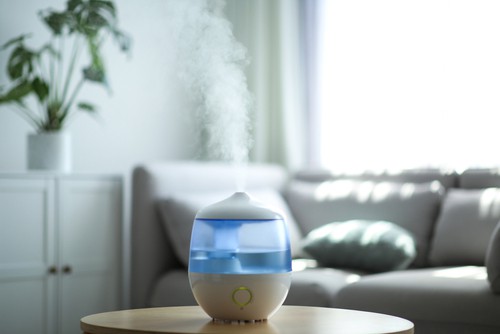
Lipstick plants thrive in humid environments, and low humidity levels can cause the leaves to turn yellow and fall off. To ensure that the plant is getting enough humidity, it is recommended to mist the leaves regularly. Misting helps to increase the humidity in the air around the plant, which is especially important in dry indoor environments.
If the air in your house is particularly dry, consider investing in a humidifier to maintain proper humidity levels. This will not only benefit your lipstick plant but also other plants and even your own health.
Another way to increase humidity around the plant is to place it in a bathroom. Bathrooms are naturally humid environments, and the steam from showers and baths can provide the necessary moisture for the plant to thrive.
However, be careful not to overwater the plant as this can lead to root rot. It is important to strike a balance between providing enough moisture for the plant to thrive and not causing any water damage to the roots.
Fertilizing and Pruning
Lipstick plants do not require frequent fertilization. However, to keep your plant healthy and thriving, it is important to fertilize it occasionally. During the growing season, which is usually in the spring and summer, you can fertilize your plant once a month. In the fall, you can reduce the frequency to once every two months.
When choosing a fertilizer, it is best to use a slow-release fertilizer. This type of fertilizer will slowly release nutrients over time, ensuring that your plant receives a steady supply of nutrients.
Alternatively, you can use a liquid fertilizer, which can be applied directly to the soil. Be sure to follow the instructions on the fertilizer package carefully to avoid over-fertilizing your plant.
Pruning is an important part of lipstick plant care. Pruning helps to promote new growth and keep your plant looking its best. You can prune your lipstick plant in the spring or summer, during the growing season.
To prune your plant, use clean, sharp pruning shears to remove any dead or damaged leaves or stems. You can also prune your plant to control its size and shape. Be sure to prune just above a leaf node, as this will encourage new growth to emerge from that point.
If you notice new growth on your lipstick plant, you can prune it back to encourage bushier growth. Simply cut back the new growth to just above a leaf node.
Blooming and Flowering
Lipstick plants are known for their bright red tubular flowers that bloom throughout the year. However, if your lipstick plant is not blooming, there could be a few reasons why.
One reason for blooming failure is lack of nutrients. Lipstick plants require regular feeding to maintain their health and produce flowers. Use a balanced fertilizer every two weeks during the growing season to ensure your plant gets the nutrients it needs.
Another reason why lipstick plants fail to bloom is lack of enough sunlight. These plants prefer bright, filtered light and may not produce flowers if they do not receive enough light. Move the plant to a brighter spot or arrange artificial lighting to help it bloom.
Temperature can also play a role in blooming. Lipstick plants prefer warm environments over 65°F. Take care that your plant is not near any open vents or drafty areas that could cause temperature fluctuations and affect blooming.
If your lipstick plant is blooming but the flowers are falling off prematurely, it could be due to overwatering. Lipstick plants prefer an evenly moist potting mix and detest drying out completely. Allow the top inch of the potting mix to dry out before watering thoroughly.
Repotting and Propagation

Lipstick plants can be propagated from stem cuttings, which is a simple and effective way to expand your collection or replace a dying plant. It is best to take cuttings in the spring or summer when the plant is actively growing.
Take a cutting that is at least 4 inches long and has several leaves. Remove the bottom leaves and dip the cut end in rooting hormone before planting it in moist potting soil. Keep the soil moist and place the cutting in a warm, bright location, but not in direct sunlight. The cutting should root in about 4-6 weeks.
Repotting is also important for the health of your lipstick plant. If the plant is outgrowing its current pot or the soil is depleted, it may be time to repot. Choose a pot that is one size larger than the current one and has drainage holes.
Fill the bottom of the pot with fresh potting soil and gently remove the plant from its current pot. Loosen any tangled roots and place the plant in the new pot, filling in around it with fresh soil. Water the plant thoroughly and place it in a bright location, but not in direct sunlight.
It is important to note that lipstick plants do not like to be root-bound, so it is best to repot them every 1-2 years. Repotting can also encourage new growth and help prevent the plant from becoming spindly.
Pest Control and Treatment
When it comes to pests, the lipstick plant is generally quite resistant. However, it can still fall victim to a few common pests, such as aphids, mealybugs, and mites. These pests can cause damage to the plant by sucking the sap from the leaves and stems, leading to stunted growth and yellowing leaves.
To control these pests, it is important to regularly inspect the plant for any signs of infestation. If caught early, a simple blast of water from a hose or a wipe down with a damp cloth can help to remove the pests.
For more severe infestations, neem oil can be used as a natural pesticide. Simply mix a few drops of neem oil with water and spray the plant, making sure to cover the undersides of the leaves where pests often hide.
In addition to pests, the lipstick plant can also be susceptible to diseases such as root rot and fungal infections. To prevent these issues, it is important to avoid overwatering the plant and to ensure that it is planted in well-draining soil. If the plant does become infected, a fungicide can be used to treat the issue.
Specific Care for Varieties
Different varieties of lipstick plants may have slightly different care requirements. Here are some specific care tips for popular varieties:
1. Aeschynanthus radicans ‘Mona Lisa’
The Aeschynanthus radicans ‘Mona Lisa’ is a popular variety of lipstick plant known for its vibrant red flowers. To care for this variety, make sure to place it in a bright, filtered light location.
Water it when the top quarter of the soil is dry, and be sure to provide high humidity levels. You can group it with other plants or use a humidifier to raise the humidity.
2. Aeschynanthus radicans ‘Variegata’
The Aeschynanthus radicans ‘Variegata’ is a variegated variety of lipstick plant that has green and white leaves. This variety requires similar care to the ‘Mona Lisa’ variety. It needs bright, filtered light and high humidity levels. Water it when the top quarter of the soil is dry, and be sure to provide good drainage to prevent root rot.
3. W Lipstick Plant
The W lipstick plant is a trailing variety of lipstick plant that is often grown in hanging baskets. This variety requires bright, filtered light and high humidity levels. Water it when the top quarter of the soil is dry, and be sure to provide good drainage to prevent root rot.
4. Basket Vine
The basket vine is another trailing variety of lipstick plant that is often grown in hanging baskets. This variety requires bright, indirect light and high humidity levels. Water it when the top quarter of the soil is dry, and be sure to provide good drainage to prevent root rot.
5. Mona Lisa
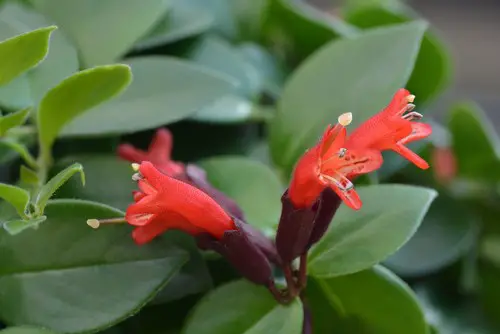
The Mona Lisa is a popular variety of lipstick plant known for its vibrant red flowers. To care for this variety, make sure to place it in a bright, filtered light location. Water it when the top quarter of the soil is dry, and be sure to provide high humidity levels. You can group it with other plants or use a humidifier to raise the humidity.
Frequently Asked Questions
How do you revive a struggling lipstick plant?
If your lipstick plant is struggling, there are a few things you can do to revive it. First, make sure it is getting enough light. Lipstick plants require bright, indirect light to thrive. If it is not getting enough light, move it to a brighter location.
Second, make sure it is not being overwatered. Overwatering can lead to root rot, which can cause the plant to die. Allow the soil to dry out slightly between waterings. Finally, consider fertilizing the plant to give it a boost of nutrients.
What are some common issues that can cause a lipstick plant to die?
There are several issues that can cause a lipstick plant to die. Overwatering is a common issue, as it can lead to root rot. Lack of light can also cause problems, as lipstick plants require bright, indirect light to thrive.
Pests such as spider mites and mealybugs can also cause issues, as they can damage the plant and spread disease.
What is the ideal watering schedule for a lipstick plant?
The ideal watering schedule for a lipstick plant is to water it thoroughly when the top inch of soil is dry. Make sure the pot has drainage holes at the bottom to prevent water from sitting in the soil and causing root rot.
In general, lipstick plants prefer an evenly moist soil, but they do not like to sit in water.
How do you propagate a lipstick plant?
Lipstick plants can be propagated through stem cuttings. Take a cutting that is 4-6 inches long and has a few leaves attached. Remove the lower leaves and dip the cut end in rooting hormone. Plant the cutting in moist potting soil and keep it in a warm, humid location until it roots.
What type of fertilizer should be used for a lipstick plant?
Lipstick plants benefit from a balanced fertilizer that is high in nitrogen. Use a fertilizer with a ratio of 10-10-10 or 20-20-20, and apply it every two weeks during the growing season.
What are some common diseases that affect lipstick plants?
Lipstick plants can be affected by several diseases, including root rot, leaf spot, and powdery mildew. These diseases can be caused by overwatering, poor air circulation, and high humidity.
To prevent disease, make sure the plant is in a well-draining pot with good air circulation, and avoid getting water on the leaves.

